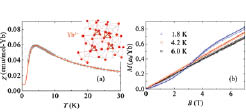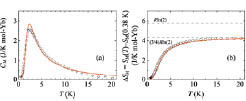Experimental Realization of a Quantum Breathing Pyrochlore Antiferromagnet
K. Kimura and S. Nakatsuji
Exploring novel and exotic phenomena associated with spin degrees of freedom has been central subject in condensed matter physics [1]. One of the most attractive systems in three dimension is a pyrochlore lattice magnet, which consists of corner-sharing regular tetrahedra of magnetic ions. The inherent geometrical frustration suppressing a conventional magnetic order often leads to a variety of unusual properties [1]. A key building unit of pyrochlore magnets is a single spin tetrahedron. Besides being a good starting point for considering the essence of physics of full pyrochlore lattice, it has been theoretically shown to possess interesting properties such as a doubly degenerate singlet state which can be labelled by scalar spin chirality [2]. To our knowledge, however, there has been no experimental realization of the S = 1/2 quantum spin tetrahedral system, partly because typical 3d transition metal ions with S = 1/2 (like Cu2+) are difficult to keep the tetrahedral symmetry due to the inherent Jahn-Teller instability.

Fig. 1. (a) The temperature dependence of the magnetic susceptibility below 30 K. Inset: Breathing pyrochlore lattice formed by Yb ions. (b) The magnetization curves at selected temperatures. Solid lines in (a) and (b) represent calculated values based on the single tetrahedron model with Heisenberg J = -6.43 K and geff = 2.569.

Fig. 2. The temperature dependence of (a) the magnetic specific heat CM and (b) corresponding magnetic entropy SM. Solid lines in (a) and (b) are fit to the single tetrahedron model. The dashed lines in (b) denote the entropy for a two level system Rln(2) and for a doubly degenerate singlet state (3/4)Rln(2).
Here, we report the new Yb-based quantum spin system Ba3Yb2Zn5O11 [3]. Polycrystalline samples were synthesized by the standard solid state reaction method. The Rietveld refinement on powder X-ray diffraction pattern has revealed that this material crystallizes into the cubic structure with space group F-43m, and Yb3+ ions form a so-called breathing pyrochlore lattice [4] characterized by an alternating array of small and large Yb3+ regular tetrahedra (Fig. 1(a), inset). Analyses of the crystalline electric field (CEF) scheme of Yb3+ ions (4f13) and magnetic susceptibility data down to 30 K show that the CEF ground state is approximated by a magnetic Kramers doublet with the isotropic effective g-factor geff = 2.66 for pseudospin-1/2. The very large gap (>500 K) to the excited states ensures that the low-temperature properties are described by pseudospin-1/2.
The temperature dependence of the magnetic susceptibility below 30 K is shown in Fig. 1(a). A broad maximum at around 4 K suggests a formation of a quantum spin singlet state due to antiferromagnetic interactions in a small Yb tetrahedron. This is supported by the magnetization curves at selected temperatures (Fig. 1(b)). Though linear above 4 K, the magnetization curves show a clear non-linear increase at B ~ 3 T below 4 K, a signature of the singlet-triplet crossover. These results are analyzed based on the pseudospin-1/2 single tetrahedron model with Heisenberg interactions J. The good agreement is obtained with J = -6.43 K and geff = 2.569, as indicated by the solid lines in Figs. 1(a) and 1(b), suggesting a formation of the doubly degenerate singlet state with chirality fluctuations predicted by the model [2]. Solid evidence for the double degeneracy is provided by magnetic specific heat CM measured at ISSP (Fig. 2(a)). CM down to 0.38 K exhibits a broad peak associated with the singlet formation without any signs of long-range order. Corresponding magnetic entropy SM is shown in Fig. 2(b). The saturated value at 20 K is close to 75% of the value expected for a standard two level system Rln(2), and 25% of magnetic entropy remains below 0.38 K. This value is fully consistent with the doublet degeneracy of the singlet state expected from the single tetrahedral model. Moreover, as indicated by the red line of Figs. 2(a) and 2(b), CM and SM are well reproduced by the model.
All the data presented in this study therefore uncover the unique doubly degenerate singlet state with chirality fluctuations at T = 0.38 K. To the best of our knowledge, this is a new quantum state of matter which has never been established in existing materials. The mechanism for the lifting of the degeneracy is highly interesting and left for the future study.
References
- [1] L. Balents, Nature 464, 199 (2010).
- [2] H. Tsunetsugu, J. Phys. Soc. Jpn. 70, 640 (2001).
- [3] K. Kimura, S. Nakatsuji, and T. Kimura, arXiv: 1404.6439
- [4] Y. Okamoto, G. J. Nilsen, J. P. Attfield, and Z. Hiroi, Phys. Rev. Lett. 110, 097203 (2013).
